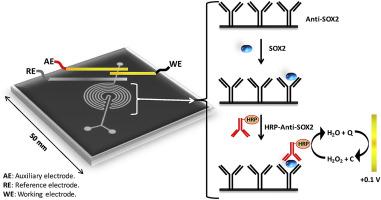当前位置:
X-MOL 学术
›
Anal. Chim. Acta
›
论文详情
Our official English website, www.x-mol.net, welcomes your
feedback! (Note: you will need to create a separate account there.)
Ultrasensitive microfluidic electrochemical immunosensor based on electrodeposited nanoporous gold for SOX-2 determination
Analytica Chimica Acta ( IF 5.7 ) Pub Date : 2020-08-01 , DOI: 10.1016/j.aca.2020.06.037 Matías Regiart 1 , Alba Marina Gimenez 2 , Alexandre T Lopes 3 , Marcelo N P Carreño 3 , Mauro Bertotti 1
Analytica Chimica Acta ( IF 5.7 ) Pub Date : 2020-08-01 , DOI: 10.1016/j.aca.2020.06.037 Matías Regiart 1 , Alba Marina Gimenez 2 , Alexandre T Lopes 3 , Marcelo N P Carreño 3 , Mauro Bertotti 1
Affiliation

|
An ultrasensitive and portable microfluidic electrochemical immunosensor for SOX-2 cancer biomarker determination was developed. The selectivity and sensitivity of the sensor were improved by modifying the microfluidic channel. This was accomplished through a physical-chemical treatment to produce a hydrophilic surface, with an increased surface to volume/ratio, where the anti-SOX-2 antibodies can be covalently immobilized. A sputtered gold electrode was used as detector and its surface was activated by using a dynamic hydrogen bubble template method. As a result, a gold nanoporous structure (NPAu) with outstanding properties, like high specific surface area, large pore volume, uniform nanostructure, good conductivity, and excellent electrochemical activity was obtained. SOX-2 present in the sample was bound to the anti-SOX-2 immobilized in the microfluidic channel, and then was labeled with a second antibody marked with horseradish peroxidase (HRP-anti-SOX-2) like a sandwich immunoassay. Finally, an H2O2 + catechol solution was added, and the enzymatic product (quinone) was reduced on the NPAu electrode at +0.1 V (vs. Ag). The current obtained was directly proportional to the SOX-2 concentration in the sample. The detection limit achieved was 30 pg mL-1, and the coefficient of variation was less than 4.75%. Therefore, the microfluidic electrochemical immunosensor is a suitable clinical device for in situ SOX-2 determination in real samples.
中文翻译:

基于电沉积纳米多孔金的超灵敏微流体电化学免疫传感器用于测定 SOX-2
开发了一种用于 SOX-2 癌症生物标志物测定的超灵敏便携式微流体电化学免疫传感器。通过修改微流体通道提高了传感器的选择性和灵敏度。这是通过物理-化学处理来实现的,以产生亲水表面,具有增加的表面积与体积/比率,其中可以共价固定抗 SOX-2 抗体。以溅射金电极为检测器,采用动态氢气泡模板法对其表面进行活化。结果,获得了具有优异性能的金纳米多孔结构(NPAu),如高比表面积、大孔体积、均匀的纳米结构、良好的导电性和优异的电化学活性。样品中存在的 SOX-2 与固定在微流体通道中的抗 SOX-2 结合,然后像夹心免疫分析一样用标记有辣根过氧化物酶 (HRP-anti-SOX-2) 的二抗进行标记。最后,加入 H2O2 + 儿茶酚溶液,酶产物(醌)在 NPAu 电极上以 +0.1 V(相对于 Ag)还原。获得的电流与样品中的 SOX-2 浓度成正比。达到的检测限为 30 pg mL-1,变异系数小于 4.75%。因此,微流体电化学免疫传感器是一种适用于实际样品中原位 SOX-2 测定的临床装置。加入 H2O2 + 儿茶酚溶液,酶产物(醌)在 NPAu 电极上以 +0.1 V(相对于 Ag)还原。获得的电流与样品中的 SOX-2 浓度成正比。达到的检测限为 30 pg mL-1,变异系数小于 4.75%。因此,微流体电化学免疫传感器是一种适用于实际样品中原位 SOX-2 测定的临床装置。加入 H2O2 + 儿茶酚溶液,酶产物(醌)在 NPAu 电极上以 +0.1 V(相对于 Ag)还原。获得的电流与样品中的 SOX-2 浓度成正比。达到的检测限为 30 pg mL-1,变异系数小于 4.75%。因此,微流体电化学免疫传感器是一种适用于实际样品中原位 SOX-2 测定的临床装置。
更新日期:2020-08-01
中文翻译:

基于电沉积纳米多孔金的超灵敏微流体电化学免疫传感器用于测定 SOX-2
开发了一种用于 SOX-2 癌症生物标志物测定的超灵敏便携式微流体电化学免疫传感器。通过修改微流体通道提高了传感器的选择性和灵敏度。这是通过物理-化学处理来实现的,以产生亲水表面,具有增加的表面积与体积/比率,其中可以共价固定抗 SOX-2 抗体。以溅射金电极为检测器,采用动态氢气泡模板法对其表面进行活化。结果,获得了具有优异性能的金纳米多孔结构(NPAu),如高比表面积、大孔体积、均匀的纳米结构、良好的导电性和优异的电化学活性。样品中存在的 SOX-2 与固定在微流体通道中的抗 SOX-2 结合,然后像夹心免疫分析一样用标记有辣根过氧化物酶 (HRP-anti-SOX-2) 的二抗进行标记。最后,加入 H2O2 + 儿茶酚溶液,酶产物(醌)在 NPAu 电极上以 +0.1 V(相对于 Ag)还原。获得的电流与样品中的 SOX-2 浓度成正比。达到的检测限为 30 pg mL-1,变异系数小于 4.75%。因此,微流体电化学免疫传感器是一种适用于实际样品中原位 SOX-2 测定的临床装置。加入 H2O2 + 儿茶酚溶液,酶产物(醌)在 NPAu 电极上以 +0.1 V(相对于 Ag)还原。获得的电流与样品中的 SOX-2 浓度成正比。达到的检测限为 30 pg mL-1,变异系数小于 4.75%。因此,微流体电化学免疫传感器是一种适用于实际样品中原位 SOX-2 测定的临床装置。加入 H2O2 + 儿茶酚溶液,酶产物(醌)在 NPAu 电极上以 +0.1 V(相对于 Ag)还原。获得的电流与样品中的 SOX-2 浓度成正比。达到的检测限为 30 pg mL-1,变异系数小于 4.75%。因此,微流体电化学免疫传感器是一种适用于实际样品中原位 SOX-2 测定的临床装置。











































 京公网安备 11010802027423号
京公网安备 11010802027423号